
Charles Lindbergh Biography
The life of an aviator seemed to me ideal. It involved skill. It brought adventure. It made use of the latest developments of science. Mechanical engineers were fettered to factories and drafting boards while pilots have the freedom of wind with the expanse of sky. There were times in an aeroplane when it seemed I had escaped mortality to look down on earth like a God. Charles Augustus Lindbergh-Overview
Lindbergh, Charles Augustus (1902-1974), an American aviator, made the first solo nonstop flight across the Atlantic Ocean on May 20-21, 1927. Other pilots had crossed the Atlantic before him. But Lindbergh was the first person to do it alone nonstop.
Lindbergh's feat gained him immediate, international fame. The press named him "Lucky Lindy" and the "Lone Eagle." Americans and Europeans idolized the shy, slim young man and showered him with honors.
Before Japan attacked Pearl Harbor in 1941, Lindbergh campaigned against voluntary American involvement in World War II. Many Americans criticized him for his noninvolvement beliefs. After the war, he avoided publicity until the late 1960's, when he spoke out for the conservation of natural resources. Lindbergh served as an adviser in the aviation industry from the days of wood and wire airplanes to supersonic jets.
Born on Feb. 4, 1902, in Detroit
Charles Augustus Lindbergh was born on Feb. 4, 1902, in Detroit. He grew up on a farm near Little Falls, Minn. He was the son of Charles Augustus Lindbergh, Sr., a lawyer, and his wife, Evangeline Lodge Land. Lindbergh's father served as a U.S. congressman from Minnesota from 1907 to 1917.
In childhood, Lindbergh showed exceptional mechanical ability. At the age of 18 years, he entered the University of Wisconsin to study engineering. However, Lindbergh was more interested in the exciting, young field of aviation than he was in school. After two years, he left school to become a barnstormer, a pilot who performed daredevil stunts at fairs.
Enlisted in the United States Army
In 1924, Lindbergh enlisted in the United States Army so that he could be trained as an Army Air Service Reserve pilot. In 1925, he graduated from the Army's flight-training school at Brooks and Kelly fields, near San Antonio, as the best pilot in his class. After Lindbergh completed his Army training, the Robertson Aircraft Corporation of St. Louis hired him to fly the mail between St. Louis and Chicago. He gained a reputation as a cautious and capable pilot.
Orteig prize
In 1919, a New York City hotel owner named Raymond Orteig offered $25,000 to the first aviator to fly nonstop from New York to Paris. Several pilots were killed or injured while competing for the Orteig prize. By 1927, it had still not been won. Lindbergh believed he could win it if he had the right airplane. He persuaded nine St. Louis businessmen to help him finance the cost of a plane. Lindbergh chose Ryan Aeronautical Company of San Diego to manufacture a special plane, which he helped design. He named the plane the Spirit of St. Louis. On May 10-11, 1927, Lindbergh tested the plane by flying from San Diego to New York City, with an overnight stop in St. Louis. The flight took 20 hours 21 minutes, a transcontinental record.
May 20, 1927
On May 20, Lindbergh took off in the Spirit of St. Louis from Roosevelt Field, near New York City, at 7:52 A.M. He landed at Le Bourget Field, near Paris, on May 21 at 10:21 P.M. Paris time (5:21 P.M. New York time). Thousands of cheering people had gathered to meet him. He had flown more than 3,600 miles (5,790 kilometers) in 33 1/2 hours.
Lindbergh's heroic flight thrilled people throughout the world. He was honored with awards, celebrations, and parades. President Calvin Coolidge gave Lindbergh the Congressional Medal of Honor and the Distinguished Flying Cross.
After the flight
In 1927, Lindbergh published We, a book about his transatlantic flight. The title referred to Lindbergh and his plane. Lindbergh flew throughout the United States to encourage air-mindedness on behalf of the Daniel Guggenheim Fund for the Promotion of Aeronautics. Lindbergh learned about the pioneer rocket research of Robert H. Goddard, a Clark University physics professor. Lindbergh persuaded the Guggenheim family to support Goddard's experiments, which later led to the development of missiles, satellites, and space travel. Lindbergh also worked for several airlines as a technical adviser.
Guggenheim Tour
Before Charles Lindbergh left for Paris, Harry Guggenheim, a North Shore multimillionaire and aviation enthusiast, visited him at Curtiss Field. "When you get back from your flight, look me up," said Guggenheim, who later admitted he didn't think there was much chance Lindbergh would survive the trip.
Lindbergh remembered and did call upon his return. It was the beginning of a friendship that would have a profound impact on the development of aviation in the United States. The two decided Lindbergh would make a three-month tour of the United States, paid for by a fund Harry and his father, Daniel, had set up earlier to encourage aviation-related research.
Daniel Guggenheim Fund sponsored Lindbergh on a three month nation-wide tour. Flying the "Spirit of St. Louis," he touched down in 49 states, visited 92 cities, gave 147 speeches, and rode 1,290 miles in parades.
"Lindbergh was seen by literally millions of people as he flew around the country," said Richard P. Hallion, historian for the Air Force and the author of a book on the Guggenheims. "Airmail usage exploded overnight as a
result," and the public began to view airplanes as a viable means of travel.
In addition, Lindbergh spent a month at Guggenheim's Sands Point mansion, Falaise, while writing "We," his best-selling 1927 account of his trip.
He met Anne Spencer Morrow
Lindbergh invented an artificial heart
Lindbergh invented an "artificial heart" between 1931 and 1935. He developed it for Alexis Carrel, a French surgeon and biologist whose research included experiments in keeping organs alive outside the body. Lindbergh's device could pump the substances necessary for life throughout the tissues of an organ.
Charles Augustus, Jr. kidnapping
On March 1, 1932, the Lindberghs' 20-month-old son, Charles Augustus, Jr., was kidnapped from the family home in New Jersey. About ten weeks later, his body was found. In 1934, police arrested a carpenter, Bruno Richard Hauptmann, and charged him with the murder. Hauptmann was convicted of the crime. He was executed in 1936.
The press sensationalized the tragedy. Reporters, photographers, and curious onlookers pestered the Lindberghs constantly. In 1935, after the Hauptmann trial, Lindbergh, his wife, and their 3-year-old son, Jon, moved to Europe in search of privacy and safety.
The Lindbergh kidnapping led Congress to pass the "Lindbergh law." This law makes kidnapping a federal offense if the victim is taken across state lines or if the mail service is used for ransom demands.
German medal of honor
While in Europe, Lindbergh was invited by the governments of France and Germany to tour the aircraft industries of their countries. Lindbergh was especially impressed with the highly advanced aircraft industry of Nazi Germany. In 1938, Hermann Goering, a high Nazi official, presented Lindbergh with a German medal of honor. Lindbergh's acceptance of the medal caused an outcry in the United States among critics of Nazism.
Opposed voluntary American entry into World War II
Lindbergh and his family returned to the United States in 1939. In 1941, he joined the America First Committee, an organization that opposed voluntary American entry into World War II. Lindbergh became a leading spokesman for the committee. He criticized President Franklin D. Roosevelt's foreign policies. He also charged that British, Jewish, and pro-Roosevelt groups were leading America into war. Lindbergh resigned his commission in the Army Air Corps after Roosevelt publicly denounced him. Some Americans accused Lindbergh of being a Nazi sympathizer because he refused to return the medal he had accepted.
After the Japanese attacked Pearl Harbor on Dec. 7, 1941, Lindbergh stopped his noninvolvement activity. He tried to reenlist, but his request was refused. He then served as a technical adviser and test pilot for the Ford Motor Company and United Aircraft Corporation (now United Technologies Corporation).
50 combat missions
In April 1944, Lindbergh went to the Pacific war area as an adviser to the United States Army and Navy. Although he was a civilian, he flew about 50 combat missions. Lindbergh also developed cruise control techniques that increased the capabilities of American fighter planes.
Withdrew from public attention
After the War, Lindbergh withdrew from public attention. He worked as a consultant to the chief of staff of the U.S. Air Force. President Dwight D. Eisenhower restored Lindbergh's commission and appointed him a brigadier general in the Air Force in 1954. Pan American World Airways also hired Lindbergh as a consultant. He advised the airline on its purchase of jet transports and eventually helped design the Boeing 747 jet. In 1953, Lindbergh published The Spirit of St. Louis, an expanded account of his 1927 transatlantic flight. The book won a Pulitzer Prize in 1954.
Conservation movement
Lindbergh traveled widely and developed an interest in the cultures of peoples in Africa and the Philippines. In the late 1960's, he ended his years of silence to speak out for the conservation movement. He especially campaigned for the protection of humpback and blue whales, two species of whales in danger of extinction. Lindbergh opposed the development of supersonic transport planes because he feared the effects the planes might have on the earth's atmosphere.
Died of cancer on Aug. 26, 1974
Lindbergh died of cancer on Aug. 26, 1974, in his home on the Hawaiian island of Maui. After his death, he was buried on the beautiful grounds of the Palapala Ho'omau Church. The Autobiography of Values, a collection of Lindbergh's writings, was published in 1978.
Lindbergh residence in Maui
The following pictures are of the Lindbergh residence and the guest house in Maui, Hawaii.
Click on the following thumbnail images to view a large image:
Palapalo Ho'omau Church Cemetery
Charles Lindbergh lived his last days on the lush Hana coast. Today he lies at rest on the serene grounds of the Palapala Ho'omau Church in beautiful Kipahulu. The limestone coral church was built in 1857. Lindbergh's grave is under the shade of a Java plum tree. Before he died, he sketched a simple design for his grave and coffin.
The inscription reads: Charles A. Lindbergh
Born: Michigan, 1902. Died: Maui, 1974.
If I take the wings of the morning, and dwell in the
uttermost parts of the sea. -- CAL
Directions:
The Palapala Ho'omau Church is located 8 miles south of Hana on the ocean side of the highway. A small road just past Mile Marker #41 leads to the church.
Click on the following thumbnail images to view a large image:
Biography of Charles Augustus Lindbergh, Sr. 1859–1924 (Father)
Reprinted from the Minnesota Historical Society Charles August Lindbergh was born in Stockholm, Sweden on January 20,
1859, the eldest of the seven children of August and Louise Lindbergh. Charles
Lindbergh graduated from the University of Michigan Law School in 1883.
Following his graduation he practiced law in Little Falls, Minnesota until 1909
when he was elected to Congress from the sixth congressional district. He held
this seat through 1916. Lindbergh was elected on the Republican ticket and soon
became one of the leaders of the progressive Republicans in Congress. His
activities as a member of this group included the attempt to unseat Joseph
Cannon as Speaker of the House; the investigation of the "money trust";
opposition to the reciprocal trade policies of the Taft administration; and
opposition to the Wilson adminstration's attempts to aid the allies during the
first years of World War I. Lindbergh's main concern, however, was the monetary
policies of both Republican and Democratic administrations. Lindbergh ran, and was defeated, in several subsequent elections: 1916
(United States Senate), 1918 (governor of Minnesota), 1920 (Congress), 1923
(special United States Senate election), and 1924 (governor of Minnesota)
during which campaign he died. In the 1910s and 1920s, Lindbergh began a number
of political magazines and newspapers, all of which failed. One paper of note
was called the Lindbergh National Farmer. Books
and pamphlets written by Lindbergh, which were widely distributed, include
Why Is Your Country at War?, The Econonic Pinch, and Who and
What Caused the Panic? His anti-war writings and speeches during World
War I caused him to be branded as a traitor and affected the outcome of the
1918 gubernatorial election. At the time, Lindbergh was prevented from speaking
in many parts of the state and was opposed by many powerful public opinion
forming agencies in the state. Following his congressional career, Lindbergh maintained law offices
in Little Falls and Minneapolis, Minnesota but much of his time was devoted to
politics, to writing, and to real estate ventures in Florida and Minnesota.
Lindbergh represented a number of individuals living in the eastern United
States who owned real estate in Minnesota. He made real estate invenstments of
his own in Florida. In 1887 Charles A. Lindbergh married Mary LaFond, daughter of Moses
LaFond, a prominent man in Little Falls. Together they had two daughters,
Lillian and Eva. Mary LaFond Lindbergh died in 1898. In 1901 Charles married
Evangeline Lodge Land, daughter of C. H. Land of Detroit, Michigan. Charles
Augustus Lindbergh was their only child. Charles August Lindbergh died in
Crookston, Minnesota on May 24, 1924; Evangeline Lodge Land Lindbergh died in
1954.
Biography of Eva Lindbergh Christie Spaeth, 1892–1985 (Sister)
Reprinted from the Minnesota Historical Society
Eva Lindbergh, daughter of Mary LaFond and Charles August Lindbergh, was born in Little Falls in 1892. She graduated from Carleton College in 1914, after which she taught school in Akeley, Minnesota. From 1914 to 1916 she worked in her father's congressional office. In 1916 she married George West Christie and the couple moved to Red Lake Falls, Minnesota where they edited and published the Red Lake Falls Gazette. Together they had two children: George Christie and Lillian Christie Johnson. George Christie, Sr. died in 1956. After his death and until 1968, Eva continued to publish the paper. On June 6, 1970 she married G. Howard Spaeth, who had been the Minnesota commissioner of taxation. Eva died on January 28, 1985.
Resources:
– Charles A. Lindbergh, 1927
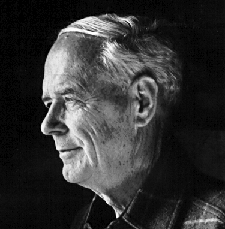
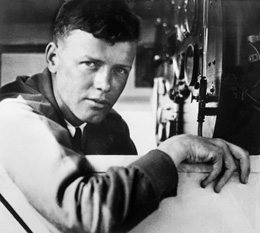
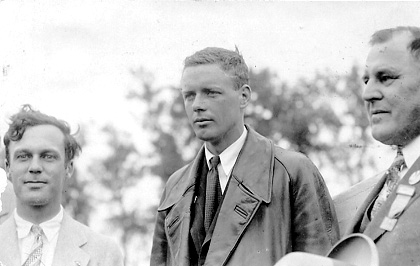

At the request of the U.S. government, Lindbergh flew to various Latin-American countries in December 1927 as a symbol of American good will. While in Mexico, he met Anne Spencer Morrow, the daughter of Dwight W. Morrow, the American ambassador there. Lindbergh married Anne Morrow in 1929. He taught her to fly, and they went on many flying expeditions together throughout the world, charting new routes for various airlines. Anne Morrow Lindbergh also became famous for her poetry and other writings.

Click to Enlarge
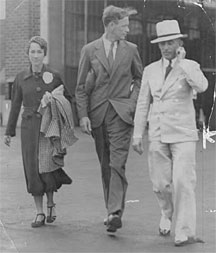












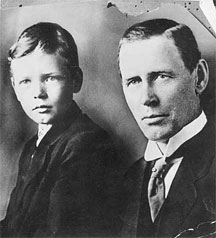
Charles Augustus Lindbergh and Charles Augustus Lindbergh, Sr
Privacy Policy | Terms and Conditions | This site is not affiliated with the Lindbergh family,
Lindbergh Foundation, or any other organization or group.
This site owned and operated by the Spirit of St. Louis 2 Project.
Email: webmaster@charleslindbergh.com
® Copyright 2014 CharlesLindbergh.com®, All rights reserved.
Help support this site, order your www.Amazon.com materials through this link.









